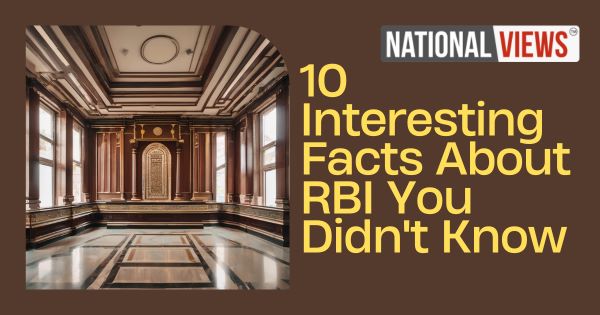Did you know that the Reserve Bank of India (RBI) recently issued a commemorative ₹90 coin, not a note, to celebrate the institution’s 90th anniversary? The special coin was released by Prime Minister Narendra Modi on April 1, 2024, at the RBI headquarters in Mumbai. The coin symbolizes the rich history and achievements of the bank, marking a significant milestone in the central bank’s journey.
Let us check out some interesting facts about RBI, the financial backbone of India:
RBI History: The Institution Began in 1934
RBI started it’s operation in 1935. It came into existence following the suggestions of the Hilton Young Commission. The RBI Act of 1934 laid down the rules for its operations. During British India, it became government’s banker and started managing public debts by taking over tasks from the Controller of Currency and the Imperial Bank of India. Sir Osborne Smith became the first Governor of the Bank. (Source)
Reserve Bank of India was Nationalized in 1949
Originally owned by private shareholders, the RBI became a national institution on January 1, 1949 that is after India gained independence. It briefly managed the finances of Burma (Myanmar) and Pakistan too. Over time, it has set up various financial institutions to aid India’s growth.
It Has the Power to Demonetize
Did you know the RBI has the power to demonetize certain banknotes? This process, known as demonetization, has been executed twice before. In 1946 High Denomination Bank Notes of Rs 500, Rs 1000 and Rs 10,000 were demonetized to curb unaccounted money. And then the High Denomination Bank Notes (Demonetisation) Act, 1978 demonetized ₹1000, ₹5000, and ₹10000, rendering them invalid.
The latest demonetization development in India involves the Reserve Bank of India (RBI) announcing a temporary halt to the exchange or deposit of Rs 2,000 banknotes.
And the Special Authority to Produce Currency
Established in 1995, the RBI operates a mint in Mysore. It is here, where banknotes and coins are produced using advanced techniques to ensure authenticity and quality.
The Story Behind the RBI Logo
The original choice for the seal of RBI was the East India Company Double Mohur, with the sketch of the Lion and Palm Tree. However, it was decided to replace the lion with the tiger, the national animal of India. After the change, It proudly displayed ‘Reserve Bank of India’ in Hindi and English, along with its founding year, 1935, symbolizing strength and stability.
Also Read: Know all about RBI Ban on JM Financial Products Limited – JMFPL
RBI’s Mascot- Money Kumar
Money Kumar, the RBI’s mascot, is a friendly and engaging character designed to make financial concepts more approachable and understandable to the general public.
Alongside Money Kumar, there is also a female equivalent named Ms. Money, adding a gender-inclusive dimension to the mascot representation.
The introduction of these mascots reflects the RBI’s commitment to financial literacy and education, using innovative and relatable means to connect with a wider audience and promote financial awareness in a fun and engaging manner.
There’s a RBI Money Museum in Mumbai
“Money” is an integral part of a country’s cultural heritage and reflects its socio-economic history. India, one of the first coin issuers in the world, has witnessed many monetary experiments throughout history.
The RBI Monetary Museum in Mumbai strives to document and preserve this legacy. It plans to set up permanent, temporary and traveling exhibits featuring India’s representative coinage, paper currency, gold bullion, financial instruments and historical curiosities. In addition, the museum aims to promote research and study of the development of money on the Indian Ocean rim and to disseminate information about currency and finance to the public.
Visitors can explore a collection of coins, banknotes, stamps, and artefacts showcasing the evolution of finance in the country.
Plus a Educational Hub in Chennai
The Reserve Bank Staff College, Chennai was established on 3 July 1963 and plays a key role in training RBI officers and other central bankers from India and abroad. (Source)
The college carries out research activities, publishes journals and books on various aspects of central banking. Apart from only training programs, the institution conducts research and publishes books and journals on banking.
Research Arm
The RBI houses the Centre for Advanced Financial Research and Learning (CAFRAL), a research wing that focuses on various aspects of the Indian economy.
CAFRAL conducts research and analysis on topics such as inflation, growth, fiscal policy, the external sector, financial markets and monetary policy. It aims to develop into a world-class institution for research and education in banking and finance, bringing together regulators, policymakers, bankers, academics, researchers and practitioners for high-level policy dialogues.
Preserving Ancient Coins and Literary Contributions
The bank’s boasts a collection of ancient coins dating back to the 6th century BC, displayed in its museum and regional offices, offering a glimpse into India’s numismatic heritage.
Additionally, with its publication division, the Reserve Bank of India prints books, journals, and reports on banking and finance, including renowned publications like the RBI Bulletin, the Report on Currency and Finance, and the Monetary Policy Report!
Also Read: The Threat of US Fed Rate Increase — How the Dollar Has Responded


